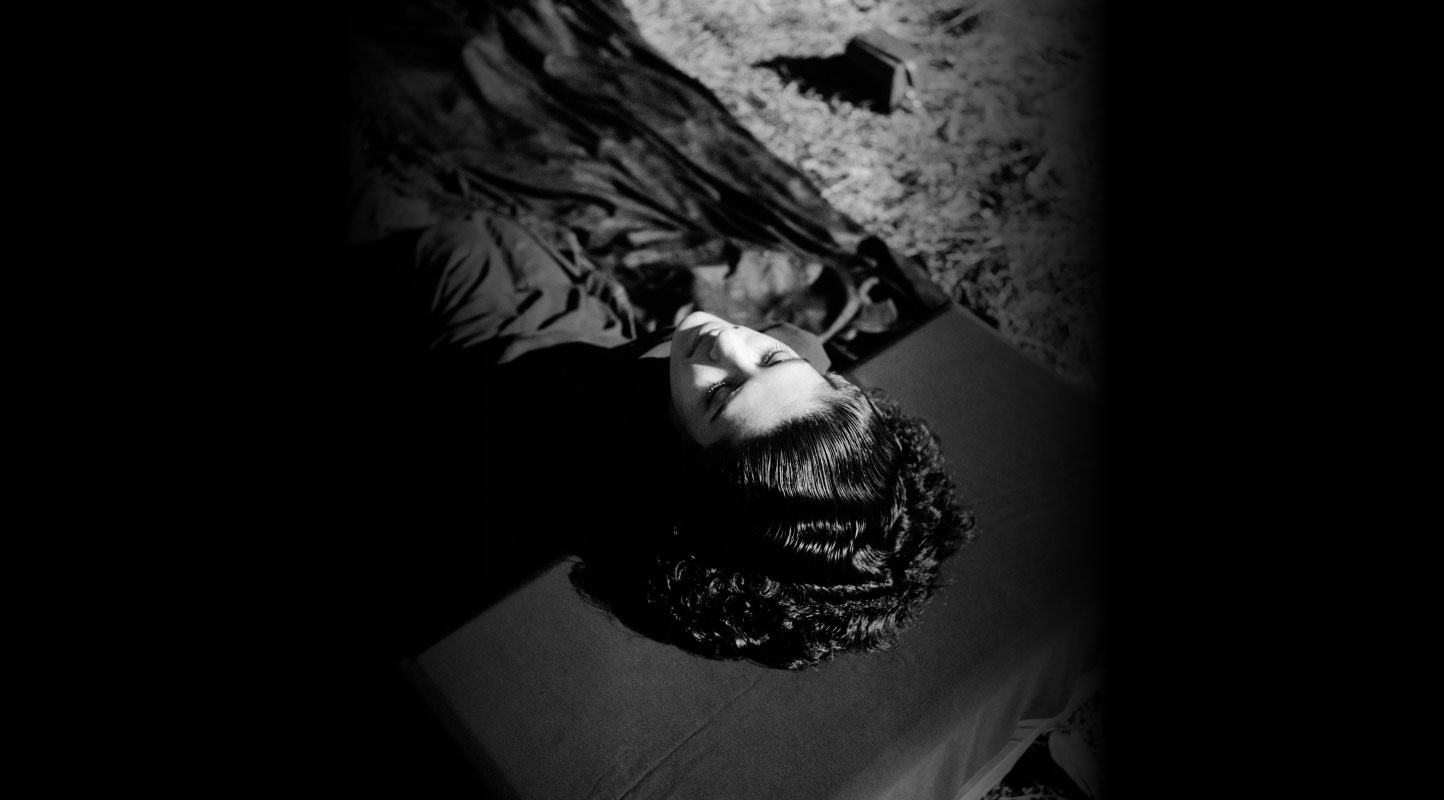Landscape and History at the Chennai Photo Biennale
The fourth edition of the Chennai Photo Biennale (CPB) emphatically platforms artists who, through their practice, seek to challenge dominant narratives in visual representation. By establishing landscapes as a repository of personal and collective histories, three of the CPB’s featured artists pursue these lines of inquiry through their practices. Through workshops with children from the local communities in Pokhran, Chinky Shukla showcases their articulation of their immediate spatial environment, entangled in a paradox of pride and distress. Osheen Siva explores the multitudes contained in the idea of Tamil identity through a layered soundscape of Vellore and Chennai. Travelling across the West Bank, Samar Hazboun responds to the colonisation of Palestine and the ongoing genocide of Palestinians by archiving their relationship with their land.

From the series Serendipity (Abhishek Panwar, Chinky Shukla. Image courtesy of the artists.)
Kshiraja (K): How did Serendipity come about through your own photographic practice and engagement with the community in Pokhran? What role did the photographic process play in the transformation of the land and the community?
Chinky Shukla: When Buddha Stopped Smiling is an ongoing long-term project supported by the National Geographic Explorer Grant. The project explores themes of memory, identity, loss and resilience of the people in the nuclear test site in Pokhran. There are many who follow the dominant narrative, but there are those who have been impacted by it. But beyond that, almost everybody is living in a state of constant fear of contamination in the food they eat or the water they drink. Since 2015, I have worked closely with the community, mainly with people who witnessed the nuclear tests first-hand, interviewing them and meeting the families of people who have been affected to learn more about the impact of the nuclear test on the people and the environment.

From the series Serendipity (Abhishek Panwar, Chinky Shukla. Image courtesy of the artists.)
In the workshop [which resulted in Serendipity], I trained sixty children over the course of two years on the basics of photography. The children’s engagement brought a fresh and honest perspective. They captured the transformation in ways I might not have noticed, focusing on the mundane nature of daily life rather than the grand narrative. One of the best examples of this is Abhishek Panwar, a specially-abled child. His photography skills are remarkable. He has weak limbs, so he would hold the camera at an angle, and he would put his finger on the flash to hold the camera properly. Accidentally, the photographs turned out so good. That is why I named the exhibit Serendipity.

From the series Serendipity (Abhishek Panwar, Chinky Shukla. Image courtesy of the artists.)
Landscape and history are deeply entwined in Pokhran. The land bears the scars of transformation. It is barren, yet resilient. Two [nuclear] tests took place, one in 1974 and the other in 1998. Through the photos of the children I mentored, I saw a layered narrative—a desolate beauty of the desert with the invisible, haunting traces of radiation, memory and resilience. The transformation is both physical and metaphorical. The landscape looks almost untouched on the surface, because nuclear radiation is invisible. When you see it, you would think everything is normal, but beneath the surface lies contaminated soil, altered water resources, and people who are caught in this continuum of pride and uncertainty. It reminds us that behind every grand event there are quieter stories, which these children brought out through their photography—stories of their family, elders, farmers, shepherds and livestock, who wake up every day to a reality shaped by decisions beyond their control. The photographic process has allowed me to unveil these layers, where a tree, a pond or a hut become repositories of the stories and histories of transformation.

From the series Palakural (Osheen Siva. Image courtesy of the artist.)
K: How did Palakural explore the spatial and aural dynamics of Tamil identity and the idea of resistance?
Osheen Siva: Jaisingh Nageswaran, the curator for the show, approached me with the idea of the multiplicity of Tamil culture. In response, I tried to capture aspects of how I am connected to my culture as well. My father is from Thiruvannamalai, and my mother is from Vellore, so it was interesting to capture everyday sounds that I grew up listening to, like the fish market, the vegetable market and the traffic.
The fascinating part was to be able to explore the parai, the drum, as a significant underlying layer of the audio piece. We went to interview and capture sounds from the Buddhar Kalai Group in Chennai. They have been seminal in reclaiming the parai as an instrument that has historically been identified with funeral processions and the Paraiyar community, which is where I come from as well. So it was especially relevant and resonant.
I tried to capture places, sounds and spaces that were quite common to me. I have never thought of them as segregated from life in Vellore. To be able to capture them separately, to fragment them, was interesting. I felt at ease occupying these spaces because I am accustomed to them, but to be able to view it from a different lens and put it all together was overwhelming and interesting, because it is a new space to explore.

From the series Palakural (Osheen Siva. Image courtesy of the artist.)
I have always been cognisant of deliberately platforming subjugated knowledge forms in my practice. Manimaran, the founder of the Buddhar Kalai Group, is doing this in such a magnificent way, and it was nice to be able to work with them and to platform that even more. The intention was to make it more accessible, the sounds and bodies of the Dalit community, which don’t necessarily get a lot of mainstream attention, especially in places like biennales. It was nice to be able to put that in and occupy the art space.

From the series Ahel el-Ard (Samar Hazboun. 2022-2024. Image courtesy of the artist.)
K: How did you approach the dispossession of Palestinian land through the Ahel el-Ard project? What were the creative decisions you made to construct a counter to the mainstream visual narrative?
Samar Hazboun: The project came as a response to the war and how the media is portraying us. I wanted us to be portrayed a little bit more closely to our true nature, which is that we are the owners, the people of this land, and we flow organically with it. I went through some of my archived work and also photographed some newer work that had to do with people who were working in relation to the land. A lot of them, you might notice, are women. This is another aspect of the project, because when foreign journalists come to Palestine, they usually do not get much access to the domestic sphere.
The project started in 2022, when I was travelling around the West Bank and I had more access to people than I do now. Now, travelling has become very complicated. There are roads that only Palestinians can use, areas that you can only access at specific hours and places you can only go to if you have a permit. Because of how detailed these restrictions are, it is a struggle to explain them in the project. It could distract the viewer, in my opinion. My hope is that when people are looking at the images, they are taken back to the original roots of who we are and what we look like, rather than thinking about the complexities that the occupation has turned us into and the way we look under occupation.
The project started with my friend, who was collecting Palestinian seeds. Because we do not have access to water, she was not able to water her plants, and so she decided to build a well in the middle of the city! When she was filling the well up with water, I decided to take my camera and go with her because this was the first time this land was going to see water in this form. It started from there, and then I gradually found farmers and people doing interesting things in relation to the land.

From the series Ahel el-Ard (Samar Hazboun. 2022-2024. Image courtesy of the artist.)
I also had a different approach [to the travel], because now I was not really looking for people, I was looking for trees. There are some images that I have not shot yet, like of a woman I found because of an avocado tree. We do not have avocado trees here, but I found one in a village, where a woman accidentally planted an avocado seed and made it a project to grow avocados in Palestine. So I found the tree first, and then the person.
I became more curious about the geography, paying attention not only to the plants and trees but also to wells, irrigation systems, access to roads to areas that are full of nature, or to settlements that are very close to these areas. In this photo (above), there is a lady in a long dress, and most of the image is green. If you look at the top right corner, you will see the settlement behind it. This area is at risk of being completely eaten up by these settlements. Because they will expand, there is an order for them to expand. It is these subtleties that I was looking for. You can see the loss which will come. We are watching land that will be taken away, demolished and destroyed, but we do not know what to do about it. I think this is my way of navigating it. To feel like, at least, I have taken a photograph of it before it was completely erased.
As Palestinian artists and creatives, we are in a constant struggle to document and archive, to make sure our ways of being are not erased. It comes as a natural responsibility and also as a healing process. If you sit at home and you do not do these things, you would feel helpless. These small things empower us; it is part of a collective resistance. Like the doctors and medical staff working in Gaza, who are doing their best with whatever they have, that is resistance as well. Writing, talking, being there as a community—all of it falls into this category. It is draining and exhausting, and that is why we need to keep coming up with new ways of doing things. My friend, who is now in Gaza, created this project called Genocide Kitchen, which documents how the people are managing to cook, what they are able to eat and how traditional recipes have changed because of the lack of resources under the genocide.
For people who work with land, once they lose this land, the way they look will change. The way their lives look will change. They are used to being with land, with the animals and with nature. All of this also needs to be documented and archived, because one day, it might no longer exist. And we will need to go back to these images to know who we originally were. It is easy to get trapped in this visual representation that the occupation is creating for us. This is one of the aims of my project.

From the series Ahel el-Ard (Samar Hazboun. 2022-2024. Image courtesy of the artist.)
To learn more about the artists and themes featured as part of the Chennai Photo Biennale this year, read Upasana Das’ short interviews with artists whose practices explore themes of power and representation and Mallika Visvanathan’s short interviews with the curators of the primary shows.




